In the UK, the latest figures from the Office for National Statistics (ONS) revealed a nuanced picture of the labor market. Unemployment inched up slightly, reaching 4.2% for the three-month period ending in February. While this remains relatively low by historical standards, it marks a departure from the trend seen since the three months ending in August of the previous year. Economists, anticipating a steadier rate, were surprised by the uptick, which came in higher than the expected 4.0%.
Concurrently, average regular pay growth showed signs of deceleration, settling at 6.0% during the same period. This continuation of a trend seen in the previous month reflects a broader pattern of slowing salary increases across the workforce. Despite this, the figure slightly surpassed expectations, indicating that wage growth, while moderating, remains robust.
Meanwhile, the number of job vacancies experienced a slight decline for the three months ending in March, albeit remaining significantly higher than levels observed before the onset of the pandemic. This suggests that while job opportunities are abundant, there may be a slowdown in the pace of new openings.
Liz McKeown, the director of economic statistics at the ONS, noted that these developments hint at a cooling of the job market. Such observations are critical for policymakers, particularly in gauging the trajectory of inflation. Paul Dales, an economist at Capital Economics, emphasized that the weakening labor market activity could provide policymakers with confidence in the sustainability of inflationary easing.
Looking ahead, market watchers anticipate the Bank of England (BOE) to respond by lowering its key bank rate from its current level of 5.25%. This move is expected to occur during the summer months, as part of efforts to mitigate the impact of inflationary pressures. However, challenges loom on the horizon, particularly concerning persistently high inflation in the United States.
The divergence in monetary policy between the BOE and the Federal Reserve presents a complex scenario. Lowering interest rates before the Fed could have implications for the value of the pound and import prices. Despite these considerations, Dales suggests that the BOE may opt for preemptive action, potentially cutting rates as early as June to counterbalance the effects of sluggish wage growth and support economic stability in the UK.
